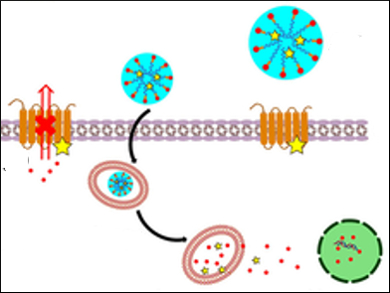Multidrug resistance (MDR), which allows tumors to evade anticancer drugs, is a serious issue in developing efficient chemotherapy approaches. As a vital contributor to drug resistance, over-expression of the membrane P-glycoprotein (P-gp) can result in reduced accumulation of chemotherapeutic agents in cancer cells. Therefore, effectively inhibiting P-gp and accumulating the therapeutics in tumors for enhanced treatment efficacy is highly important.
Bengang Xing, Nanyang Technological University, Singapore, and colleagues developed a smart stimulus-responsive self-assembled system for controlled drug release and simultaneous inhibition of P-gp function. The developed nanogel (pictured blue) combines a short peptide-Dox prodrug (PD) and the P-gp inhibitor (Verapamil, VER). The peptide sequence was prepared by Fmoc solid-phase synthesis and reacted further with Dox to form the PD, after which a mixture of the PD and VER self-assembled in water at 60 ºC.
These inhibitor-encapsulated nanogel enhances drug accumulation in resistant cancer cells. Importantly, the nanogels have significantly higher antitumor activity than free Dox drugs, thereby greatly reversing tumor resistance. According to the researchers, this work shows that self-assembly of bioactive agents with synergistic effects into nano-drugs could improve tumor therapy.
- Stimulus-Responsive Short Peptide Nanogels for Controlled Intracellular Drug Release and Overcome Tumor Resistance,
Bengang Xing, Linna Lyu, Fang Liu, Xiaoyong Wang, Ming Hu, Jing Mu, Haolun Cheong, Gang Liu,
Chem. Asian J.2017.
DOI: 10.1002/asia.201601704



